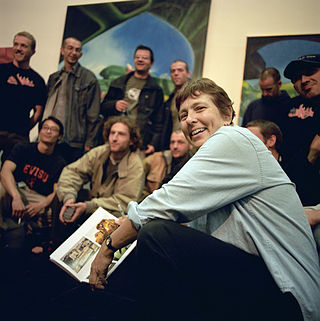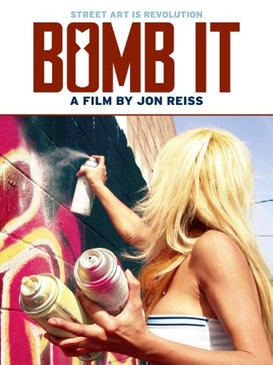Miss Van, also known as Vanessa Alice, is a graffiti and street artist. Miss Van started painting on the street of Toulouse alongside Mademoiselle Kat at the age of 18. Today, she is now internationally known as a street and fine artist. Primarily, her work is marked by the use of unique characters, called poupées, or dolls. Miss Van's work has appeared on streets internationally, although she also exhibits canvases in galleries across France, Europe and the United States. Today, her work is characterized by both street art and fine art, blurring the lines between both worlds.

ZEPHYR, born Andrew Witten, is a graffiti artist, lecturer and author from New York City. He began writing graffiti in 1975 using the name "Zephyr" in 1977. He is considered a graffiti "elder", who along with Futura 2000, Blade, PHASE 2, CASH, Lady Pink and TAKI 183 invented styles and standards which are still in use.
George Lee Quiñones is a Puerto Rican artist and actor. Quiñones rose to prominence by creating massive New York City subway car graffiti that carried his moniker "LEE". His style is rooted in popular culture and often with political messages.

Lady Pink, born Sandra Fabara (1964), is an Ecuadorian-American graffiti and mural artist.

Martha Cooper is an American photojournalist. She worked as a staff photographer for the New York Post during the 1970s. She is best known for documenting the New York City graffiti scene of the 1970s and 1980s.

Bomb It is an international graffiti and street art documentary directed by Jon Reiss that premiered at the 2007 Tribeca Film Festival. Filmed on five continents, featuring cities such as New York, Cape Town, London, Paris, Amsterdam, Tokyo, Berlin and Sao Paulo, Bomb It explores the interplay between worldwide graffiti movements, the global proliferation of "Quality of Life" laws, and the fight for control over public space.

Claw Money is a New York-based graffiti writer turned fashion designer. In 2009 Tag au Grand Palais in Paris, France named Claudia Gold a/k/a Claw one of the most influential graffiti artists of all time.
Sara Rosen was the publisher of Miss Rosen Editions, her own imprint, at powerHouse Books, where she was also Associate Publisher and Publicity & Marketing Director. She left after ten years to start her own company, Miss Rosen.

Graffiti in New York City has had a substantial local, national, and international influence.
Sacha Jenkins is an American television producer, filmmaker, writer, musician, artist, curator, and chronicler of hip-hop, graffiti, punk, and metal cultures. While still in his teens, Jenkins published Graphic Scenes & X-Plicit Language, one of the earliest 'zines solely dedicated to "graffiti" art. In 1994, Jenkins co-founded Ego Trip magazine. In 2007, he created the competition reality program ego trip's The (White) Rapper Show, which was carried by VH1. Currently, Jenkins is the creative director of Mass Appeal magazine.
Michael Anthony Pegues is a contemporary American visual artist based in New York City.

Malina Suliman is an Afghan graffiti artist, metalworker and painter. She was born in Kabul. As a child, she and her family were forced to flee her home province to live in Kandahar, Afghanistan. Her work is considered to challenge traditional Muslim culture like the burqa. According to Suliman, "The burqa is a way of controlling, but in the name of respect. Every culture or religion gives a different name for the burqa. It is honor, culture, and religion. Really, it just controls the woman and keeps her inside." Malina's work has gained the attention of the Taliban and traditional Muslims, resulting in having received threats from the Taliban towards Suliman and her family. The artist was subject to physical threats, rocks have been thrown at her as she conducts her work.

Shamsia Hassani is an Afghani street artist, a fine arts lecturer, and the associate professor of Drawing and Anatomy Drawing at the Kabul University. She has popularized "street art" in the streets of Kabul and has exhibited her art in several countries including India, Iran, Germany, United States of America, Switzerland, Vietnam, Norway, Denmark, Turkey, Italy, Canada, and in diplomatic missions in Kabul. Hassani paints graffiti in Kabul to bring awareness to the war years. In 2014, Hassani was named one of FP's top 100 global thinkers. She was recognized as one of the BBC's 100 women of 2021.
Feminist activism in hip hop is a feminist movement based by hip hop artists. The activism movement involves doing work in graffiti, break dancing, and hip hop music. Hip hop has a history of being a genre that sexually objectifies and disrespects women ranging from the usage of video vixens to explicit rap lyrics. Within the subcultures of graffiti and breakdancing, sexism is more evident through the lack of representation of women participants. In a genre notorious for its sexualization of women, feminist groups and individual artists who identify as feminists have sought to change the perception and commodification of women in hip hop. This is also rooted in cultural implications of misogyny in rap music.
Aiko Nakagawa, known as Lady Aiko or AIKO, is a Japanese street artist based in Brooklyn, New York. She is known for her ability to combine western art movements and eastern technical, artistic skills, as well as for her large-scale works installed in cities including Rome, Italy, Shanghai, China and Brooklyn, New York.
Vaj, also known as Vaj Graff, is a feminist street artist based in Bristol, UK. Active as a feminist graffiti artist since July 2015, her style is similar to Banksy. In January 2016, she controversially added legs and pubic hair to the Queen Victoria statue in College Green, Bristol. This was removed within 24 hours by the local council. Her art has a feminist purpose in an area dominated by men.
According to scholar Virginia Mackenny, performance art is a great tool to mold and remold gender because performance art, in most instances, includes a direct subversion to everyday conventions. MacKenny also writes that feminist performance Art had a large presence "in the late '60s and early '70s in America when, in the climate of protest constituted by the civil rights movement and second wave feminism." There are several movements that fall under the category of feminist performance art, including Feminist Postmodernism, which took place during 1960-1970 and focused on the exploitation of women's bodies as a means for profit. Similarly, the Chicanx movement emerged in East Los Angeles during the 1970s, and focused on the Vietnam war, which was considered a post-apartheid movement.

Danielle E. "Utah" Bremner and Jim Clay "Ether" Harper VI are American graffiti artists, called the "Bonnie and Clyde of the graffiti world". They have tagged trains and buildings in over 30 countries on five continents, and have made books and videos about their exploits. They have also been arrested, fined, and served multiple prison sentences for vandalism. Their use of social media has been used as an example in a book about graffiti artists, and they have been the subjects of a video exhibit and a song.









